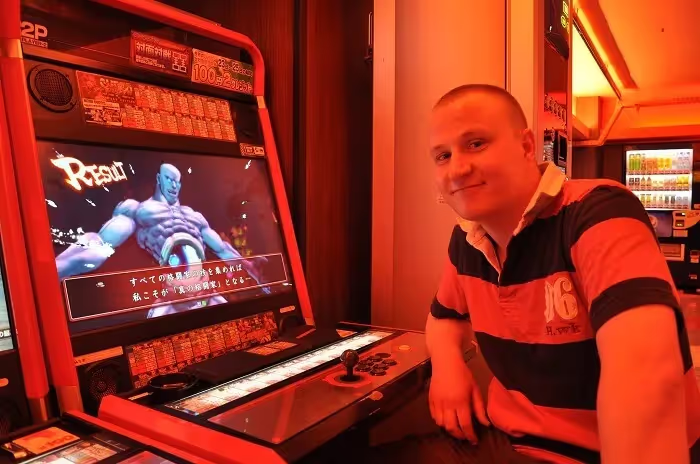If you didn’t know Dead Cells was developed by Bordeaux-based indie dev Motion Twin, a quick trip into its menu options should give you a clue: select the "baguette" option and your health pickups become delicious patisserie snacks. From the ironic thumb-ups of Dead Cells’ silent protagonist to NPCs who poke fun at their own game design, humour permeates Motion Twin’s now fully released rogue-lite, Metroidvania action-platformer. And yes that’s a mouthful, but it really is the best way of describing what Dead Cells is like to play. Take a pinch of any classic Metroidvania’s unlockable exploration system, a smattering of Rogue Legacy’s progression, a dash of Spelunky’s procedurally generated levels and intense timed action, add in the challenging combat of Hollow Knight and you have the foundations for Dead Cells. What could be a mess of influences is instead a fun and exhilarating twist on the genre with surprising hidden depths making for a replayable and rewarding experience.

Things start simply enough, dropping you (quite literally) in media res, as a blob of greenish goo that falls from the ceiling and rolls towards a headless body, soon animating it into life. Instinctively you know it’s a sequence you will see many times. From there it’s straight into combat, on-screen button prompts your only tutorial on the basics of jump, attack and roll. You’re given a rusty sword to start you off and a choice between a shield with a parry that inflicts damage, or a bow with renewable ammo. Make it through the first area — a grimy prison littered with monsters — and you’ll meet the Collector, a mysterious figure who offers to swap your cells, blue orbs collected from random enemy drops, for handy upgrades such as a refillable health flask and shiny new weapons. You will come to savour these ‘safe zones’ as a welcome breather between the frantic combat and a chance to offload precious cells. Here you can also assign up to three ‘mutations’ granting useful boosts such as an extra life, more ammo or more damage for chained kills.
But lest you forget this is not just an action-platformer, this is also a rogue-lite and one that doesn’t shy away from tough gameplay. Make no mistake: you will die a lot and permanently. Very little remains after permadeath, all stat boosts to health and damage (levelled up through collectable scrolls), weapons, gold and cells not banked are lost. Later on, unlockables allow you to hold onto to a set amount of gold and permanent exploration runes remain (more on those later) but everything else is a goner, returning you to your base stats and HP. You see, in Dead Cells you don’t upgrade your player, but rather upgrade your opportunity, ensuring on each successive run an increased probability of finding a better weapon and stacking the odds slightly more in your favour.

And while death in Dead Cells can be swift and brutal, knocking you on your arse if you stumble blindly into the fray unprepared, like Miyazaki’s masterpiece, Dark Souls, death is also fair, usually the result of not using a health flask when you should have, or failing to react to an enemy’s telegraphed attack. Subsequent runs allow you to understand your own movement and enemy timings better; figure out which enemies will give chase and which you can safely snipe away at from above or below. You’re equipped with an effective roll which can dodge almost all attacks and resets after a few seconds. And you’ll want to use it often, including when going through doors which not only feels good (and sounds great) but also stuns nearby enemies. In a game that’s all about dispatching enemies quickly and interrupting attack animations, while minimising your potential for taking damage, it’s a skill you’ll want to master fast. The same can also be said for the downward jump, which adds on a hefty amount of damage to anyone unlucky enough to be below. You’ll need to think vertically as well as horizontally, using platforms and doors to your advantage. A double jump comes as standard, however it can feel rather short and heavy compared to other Metroidvanias of this generation and in the light platforming sections has to be handled carefully.

You won’t want to hoard resources on your rechargeable secondary weapons or grenades either, it’s very much a case of use it or lose it. The reward for playing Dead Cells is not really defeating the final boss and making it to the credits, the reward is unlocking more of the game itself, more story, more levels, more ways to play. Progression is made inch by inch, but progression hard-fought for is always more rewarding.
And there’s certainly plenty to unlock: over fifty weapons in total and that’s not including upgrades to health flasks and mutations. Motion Twin offers an outstanding array of choice in its armoury, from firebrands that set enemies alight, to giant slow impalers and whips that cause critical damage if struck at the tip. Secondary weapons are mapped to the trigger buttons, which can at times be disappointingly unresponsive to execute but are crucial to increasing damage rate through various elemental combinations. Useful items such as the sinew-slicer drop a mini turret, which must be powered by standing within a set proximity, or grenades which can burn or freeze and, depending on randomly assigned modifiers, spew out attacking worms or a toxic cloud. These modifiers make for a surprising and emergent combat system creating useful (and explosive) chain reactions: find a sword that covers enemies in inflammable oil, for instance, and pair with a sinew-slicer’s modifier to chuck out fireballs, for satisfying pyrotechnic results.

You won’t just be hacking, slashing and dying your way through levels, however, since exploration and discovery are key to a good Metroidvania. Permanent upgrades in the form of special runes (dropped after defeating ‘elite’ enemies in certain levels) unlock special abilities in the environment and grant access to new areas and weapons previously unreachable. Once you have the Vine rune from the Promenade, for instance, you can access the Toxic Sewers via the Prisoners’ Quarters, which in turns unlocks the Teleportation rune, which unlocks the Ossuary and so on. Eventually, you’ll have multiple branching pathways, allowing you to tailor your playthrough to avoid certain enemies, take a faster route or grab the most loot, depending on your preference, and prevent runs from becoming too repetitive.
Similarly, timed doors in each level encourage another way to play; you’ll need to blast through the levels, potentially missing useful collectables, to reach them in time but you’ll be rewarded with rare blueprints and extra cells — if you can make it to the end of the level to cash in. It’s another clever way Motion Twin has of staving off repetitive play by allowing you to switch up your approach, not just in weapon combinations but in how you choose to navigate the game.

There are also ‘story’ rooms hidden in each level which change as you find them, so over multiple runs you might build up a picture of the guard from the Prisoners’ Quarters with his book of prison management tips, and then perhaps find his secret sun lounger on the top of the Ramparts, all the better to spy on the corpses below. Search carefully and you’ll find a hidden stash of health or useful items in these rooms. Other areas hint at dodgy experiments gone wrong or a mad king’s orders and here your silent protagonist will shrug, thumbs up and comically look around, almost mugging to the camera, providing moments of genuine relief and humour in between all the relentless action and tension while on a run.

Finally, a note on the visuals — if you can’t tell already from the screenshots, Dead Cells is wrapped up in a beautiful pixel package that’s even better in motion. Brief moments of calm in between the action as you climb a tower or descend into the depths allow you to focus on something other than the next monster out to get you. The lighting in each level is particularly effective, whether it’s the soft glow of a sunset atop the Clock Tower or the bright green haze of toxic acid in the sewers. Each area feels unique and easily recognisable through colour scheme and enemy types, from the deep red of the Ossuary or the clean steely lines of High Peak Castle. Occasionally action on screen can get messy and hard to read: add in environmental effects, three monsters and flying projectiles and it’s hard to see your character and spot enemy wind-ups. One boss fight in particular with the Clock Master suffers badly from this, the screen a whirlwind of flying daggers, swords and chains to avoid that occasionally leaves you squinting at the screen wondering what’s just happened. The price you pay for pretty pixels.

While doubters will question whether the world needs a Metroidvania rogue-lite action platformer to add to a bulging, blurry genre, those that play the game will be quickly won over by its charm, depth and rewarding gameplay. There’s much to draw you in whether you want to speed-run your way through the levels, battle the daily challenges or explore every hidden nook and cranny. Minor niggles such as a weak jump and occasionally fiddly trigger controls do little to dampen the fun as you throw yourself through run after run. Motion Twin has achieved a difficult thing: a complex, fast-paced action platformer that gives a deep and difficult challenge for those who want to seek it out. Its punishing but fair permadeath succeeds in ratcheting up the stakes and, at its height, pulling off exhilarating near-misses that feel rightly earnt through your growing skill set and understanding of the game. Rather than hurl your controller in frustration, each death only makes you more determined that your next run will be more accomplished. You know you should be able to beat the game given the right amount of luck and skill, the question is, can you?
You can subscribe to Jump Chat Roll on your favourite podcast players including:
Let us know in the comments if you enjoyed this podcast, and if there are any topics you'd like to hear us tackle in future episodes!




